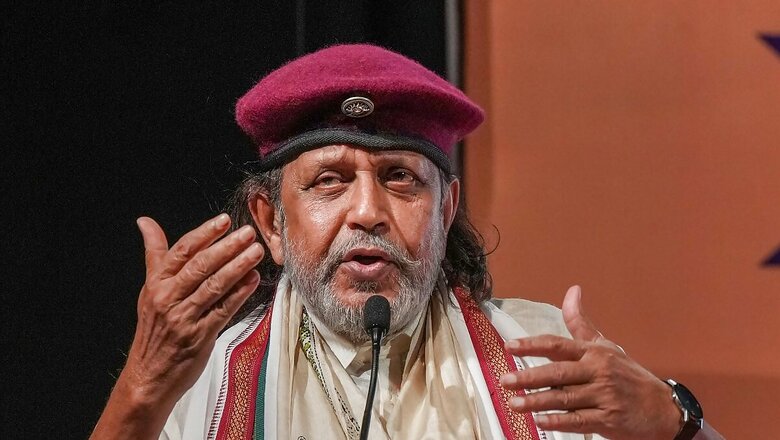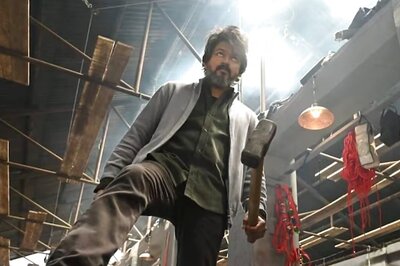
views
There have been actors, there have been stars, there have been icons and legends, and then there are a handful like Mithun Chakraborty—those who check all these boxes and then some. In the fever dream that is Indian cinema, Chakraborty stands as its most vivid hallucination.
For many, the news of Mithun da receiving the Dadasaheb Phalke Award—India’s highest cinematic honour—might not sit well. One can’t blame them because, usually, for them, those conferred with such awards are cut from a particular kind of fabric. Today, Mithun Chakraborty might not fit that mould, but make no mistake—if there is anyone deserving of the highest honour this nation can bestow for cinema, then Mithun Chakraborty it is.
Awards honouring a lifetime of achievements in cinema are usually accompanied by an oft-misinterpreted rider: for contribution to cinema. This contribution is commonly understood to mean creating great films, pushing the creative envelope, inventing techniques, or influencing people’s thoughts in a particular way. In this context, one wonders what then Ashok Kumar’s actual contribution to the field was. Or what brilliant logic fuelled the decision to honour Yash Chopra with a Phalke before Dev Anand? And, as someone whose onscreen persona normalised violence as a means of justice at all costs, what exactly was the Phalke Award honouring when it recognised Amitabh Bachchan?
By comparison, Chakraborty would be the first true instance where the Phalke is awarded to an actor-star who most likely deserved it but might have been overlooked. For this writer, the jury’s decision feels as real as Mithun da’s aura and his cinematic legacy. Chakraborty’s filmography reads like a mad lib created by a committee of film school rejects, auteurs, master craftsmen, Bollywood fanatics, and those who swore they saw God in lava lamps, dusty roads, neon-lit bars, and Ooty’s misty meadows.
A fellow traveller, Gouranga Chakraborty, was said to be committed to the Naxal movement in the early 1970s but chose the mainstream after witnessing a tragedy – his only brother was electrocuted in a freak accident. He enrolled at the prestigious Film and Television Institute of India (FTII), and the legendary Mrinal Sen handpicked him to play the lead in Mrigaya. Chakraborty won the National Award for his debut.
Most actors would have used this as a springboard into serious, contemplative roles, with perhaps the occasional foray into popular cinema. However, unlike his fellow FTII graduate, Shabana Azmi, Mithun was unable to evoke much intrigue. Bombay cinema couldn’t care less, and the art-house club had their own repertory of similar raw talent (read: Naseeruddin Shah, Om Puri, et al.). Chakraborty landed a few supporting gigs, such as Do Anjaane and Phool Khile Hai Gulshan Gulshan. His real ‘job’ on the former was to accompany Rekha on shopping sprees in Calcutta. He is said to have practically cried himself to sleep during those lean days, drinking water to stave off hunger, until Jaya Bachchan recommended him. Lady Bachchan’s good word got him work.
Chakraborty zigged where others zagged. He did not confine himself to any particular genre. He played a Bond-esque Gunmaster G9 in a series of films directed by Ravikant Nagaich, who had ushered in Jeetendra’s stardom as the white-pantsed pyjama-ister Gopal in Farz (written by Arudra, yours truly’s late grandfather). He hitched his wagon to the likes of middle-cinema master Basu Chatterjee, human drama king Bapu, and the disco-driven Babbar Subhash.
In the early 1980s, Mithun featured in some of the most memorable films of the period – Sitara and Hum Paanch, to name a couple – and this was before his Disco Dancer avatar was unleashed. Watching Mithun in Disco Dancer after Mrigaya and Sitara could feel like Marlon Brando following On the Waterfront by becoming the frontman for the Village People. Chakraborty went from a promising actor to a cultural sensation, and Disco Dancer remains a phenomenon to this day in India, Russia, and several African nations.
To reduce Chakraborty to his disco avatar would be to do a disservice to the depth of his talent. Even in the shadow of Disco Dancer or a plethora of films that catered only to what was referred to as the front stall audience, the actor picked up films that showed the sheer range he possessed. Take Sheesha, for instance, a film that failed at the box office but showcased one of Chakraborty’s finest performances. In the post-#MeToo era, his portrayal in the film takes on new resonance, a testament to his ability to tap into complex emotions long before they became part of the mainstream discourse.
Chakraborty’s career is nothing if not a testament to the power of “yes.” Yes, he could play a tribal; he could also be a gun master, a dancer, a boxer, and, at the same time, portray a disillusioned freedom fighter in Tahader Katha and become the revered spiritual leader Ramakrishna Paramahamsa with such conviction you’d swear he spent years in deep meditation rather than perfecting his pelvic thrusts. His partnership with director Bapu, which began with Hum Paanch, a remake of the Telugu Mana Voori Pandavulu, stands as one of Indian cinema’s most fruitful collaborations. Their films together, including Pyari Behna and Prem Pratigya, showcased a different side of Chakraborty—earnest, grounded, and capable of profound emotional depth.
The 1980s were Chakraborty’s decade of dominance. The 1990s saw him redefine assembly line production. Chakraborty went from being a Naxalite to India’s highest taxpayer for a few years in the 1980s and became a successful hotelier in the 1990s. He made more than 30 odd films that were shot in Ooty in quick succession while focusing on his hotels.
The 1980s could have ushered in a new phase for him as an actor had he not been overlooked by some filmmakers, thanks to his link-up with Sridevi. Imagine Chakraborty playing Vinod Khanna’s character in Chandni—a role tailor-made for him. Interestingly, while most leading filmmakers worked with Mithun, Yash Chopra never considered him. His not working with Chakraborty remains one of Hindi films’ enduring mysteries. Chopra, who had no qualms casting actors as diverse as Raaj Kumar and Shatrughan Sinha—the kind that wouldn’t be readily associated with Chopra’s polished universe—he seemed to have an inexplicable blind spot when it came to Mithun.
Beneath the kitsch and the camp, there lies a serious artist and advocate. Chakraborty has been a vocal supporter of film industry workers, using his star power to push for better conditions for the unsung heroes behind the camera. The Dadasaheb Phalke Award isn’t just a recognition of Chakraborty’s ‘contributions’ to Indian cinema in the manner many social commentators would prefer. It’s an acknowledgement of his role as cinema’s social power, reflecting at us the medium’s wild, weird, and wonderful possibilities. It’s a celebration of an impossibly eclectic career that defies logic, laughs in the face of consistency, and reminds us that in the end, it’s not about the roles you play both on and offscreen, but how fabulously you play them.
The writer is a film historian. Views expressed in the above piece are personal and solely that of the author. They do not necessarily reflect News18’s views.

















Comments
0 comment